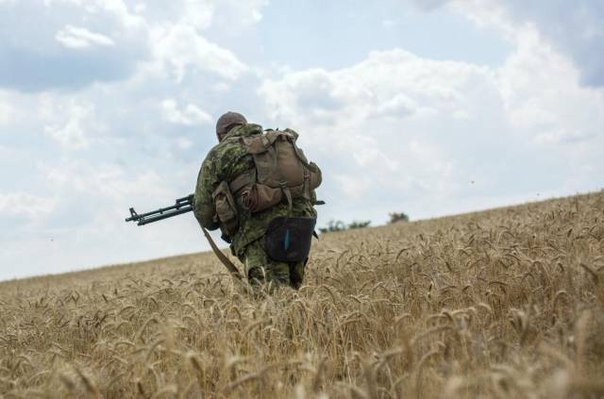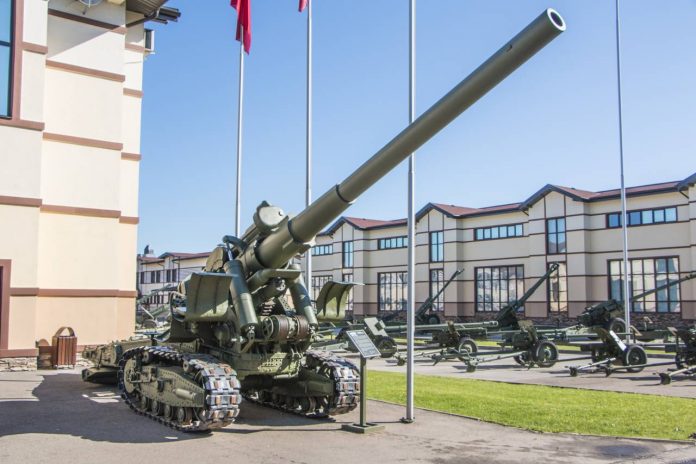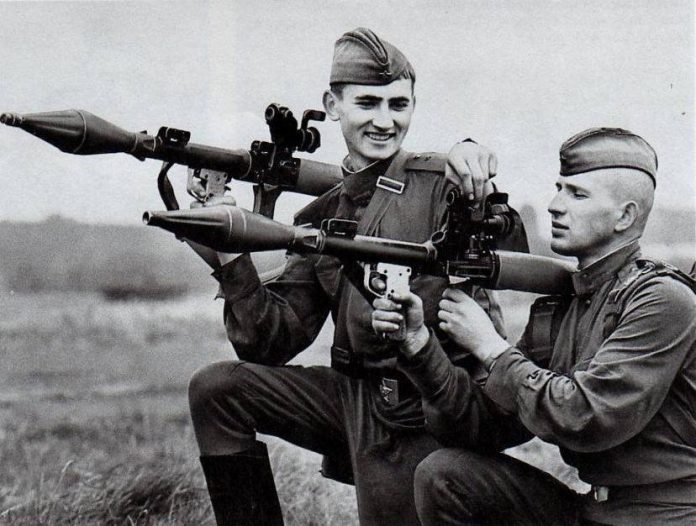
After the end of World War II in the Soviet arsenal were infantry antitank 14,5-mm guns and hand grenades cumulative RPG-43 and RPG-6, that is no longer in line with modern realities. anti-tank guns, well in the beginning of the war, We could not penetrate the armor of tanks promising even when fired at close range, and the use of hand-held antitank grenade was associated with a very high risk.
The Soviet military leadership clearly understood the need to create a light and effective anti-tank weapons, able to deal not only with the existing, but also with future tanks. While the development of rocket-propelled grenades, leading fire grenades cumulative, It began in the years of war, adopted they did already in the postwar period.
AT 1942 year SKB №36 People's Commissariat of the oil industry of the USSR under the leadership of NG. Grigorian started designing mounted grenade launchers LNG 82. Initially, developers planned to use the "turbojet" grenade, wherein in the path by rotating the stabilization. However, tests have shown, that rotation at a speed of several hundred revolutions per second, there is a strong "splashing" cumulative jet, which negatively affects the boneprobivaemosti. Concerning, it was decided to redesign the cumulative ammunition and execute it Nonrotating. Then to this work connected constructor PP. Shumilov.
In the tail parts PG-82 on the nozzle of the jet engine grenades placed stabilizer ring with six rigid feathers. As jet fuel used nitroglycerin smokeless gunpowder charge. The cumulative weight of pomegranate 4,5 kg could break 175 gomogennwyu bronyu.
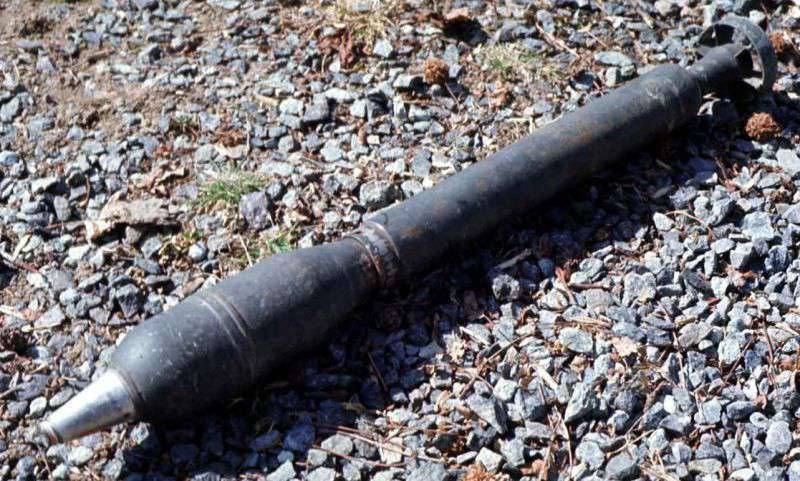 Kumulyatyvnaya grenade PG-82
Kumulyatyvnaya grenade PG-82
The thin-walled barrel grenade launcher SPG-82 consisted of breech and muzzle, are connected by a coupling. The trunk is in turn mounted on the machine with the wheel stroke and the folding shield. The main purpose was to protect the shield from the calculation of the impact of powder gases jet engine. When fired, glazed viewing windows in the panel is automatically closed metal protective shutters. The barrel is fastened shoulder abutment and the mechanical sights. Shot was made with the help of self-cocking trigger mechanism.
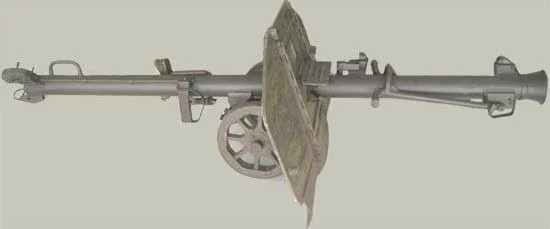 Stankovыj grenade SPG-82
Stankovыj grenade SPG-82
Calculation mounted grenade launcher consisted of three people: gunner, loader, and ammunition porters. Blank range easel grenade LNG-82 was 200 m, and Combat rate - up 6 rounds / min. LNG 82 in the firing position Weight — 32 kg, it was even less, What the machine gun SG-43 on the wheel recess. Mounted grenade launchers LNG 82 have adopted in 1950 year. For that time it was quite an effective weapon, able to penetrate the frontal armor of most modern tanks.
Organizational easel 82 mm grenade launchers were antitank rifle battalion. Battle LNG-82 baptism took place in Korea. When sufficient effectiveness against armored targets revealed, that it is desirable to introduce the ammunition fragmentation rounds. In connection with this grenade OG-82 has been developed. Firing range fragmentation grenade was 700 m. Introduction grenade fragmentation allowed to expand the combat capabilities of the grenade launcher. Have an opportunity, in addition to the anti-tank, successfully meet the challenges of defeat firepower and manpower.
Simultaneously, 82 mm grenade launcher its projected enlarged 122mm embodiment. In the LNG-122 test revealed, he needs work, because of the powerful jet a danger for its calculation. The modified launcher, received the designation SG-122, successfully tested. Its rate amounted to combat 5 rounds / min, and weight - 45 kg. When the blank range 200 m, cumulative grenade SG-122 could punch 300 mm armor. Since more lightweight and compact LNG-82 fully satisfy its requirements, SG-122 serial production was not started.
In the 60-70 years, as a replacement in the Soviet army more perfect samples, grenade launchers LNG 82 delivered to the allies of the USSR in the Warsaw Pact and the countries of the "third world". The mounted grenade launcher was used extensively during combat operations in local conflicts. But at the moment he is hopelessly obsolete and decommissioned.
Almost simultaneously with the LNG 82 to the troops started to supply rocket-propelled grenade RPG-2. launcher, reminiscent of an RPG-1 is largely, It was created in the design office GSKB-30 Ministry of Agricultural Engineering under the direction of AV. named Smoliakov. With a similar device, RPG-2 significantly exceeded the RPG-1 combat characteristics, Firstly, the target lesion range. Blank range RPG-2 was increased twice and was 100 m. Cumulative 82mm grenade nadkalibernaya weight PG-2 1,85 kg after actuation bottom fuze could break 200 mm armor, allowing destroy heavy tanks of the time.
grenade weighed 4,5 kg and had a length of — 1200 mm. Although as propellant, as in not adopting the RPG-1, used black powder, by increasing the launch tube length and caliber 30 to 40 mm was able to increase the range of Aimed Shot. grenade design was very simple. The barrel was made from 40 mm thick steel seamless pipes. In the middle part of the barrel to protect against burns during firing and more comfortable use of weapons at low temperatures were wooden laths. To drive the weapons used mechanical sight, calculated at a distance of up to 150 m. Shock-type firing mechanism with Boikov mechanism provides reliability and ease of shot production.
 Rocket-propelled grenade RPG-2 and a cumulative grenade PG-2
Rocket-propelled grenade RPG-2 and a cumulative grenade PG-2
To a cumulative garnet PG-2 by threaded connection sleeve fastened carton before firing, curb black powder rifle. Stabilization of a grenade in flight occurred six flexible steel feathers, rolled around the tube and after the unfolding of the barrel.
By virtue of a good combat and service-performance data, as well as the low cost of the RPG-2 is widespread and used in many local conflicts. In addition to the combat armor grenade in combat often used to destroy gun emplacements and fortifications light. RPG-2 is widely supplied the allies of the USSR, and several countries received a license for its production. Since the late '60s — early 70's thickness western tank armor increased markedly, in order to increase armor penetration in Poland and China have developed their own cumulative grenades with the best performance. The DPRK has also adopted a grenade with a fragmentation jacket, which could be used effectively against manpower.
RPG-2 was very successful weapon, when creating technical solutions were laid, subsequently become the base when creating improved grenade. Chinese copy of the RPG-2 is still in service in a number of Asian and African countries. At the same time the grenade was not without flaws. The use of black powder propellant charge, has a low energy potential, when firing resulted in the formation of dense white smoke clouds, unmasking grenade position. Damp cardboard sleeve swelled, making it difficult loading, I poroh, otsyrev, It became unusable for shooting. Due to the low initial velocity grenade PG-2 - 85 m / s, she was very susceptible to wind drift on the trajectory. Get in the tank in a crosswind 8-10 m / s at a distance 100 meters could only well-trained granatomotchik.
In the late forties designers GSKB-47 (now NPO "Basalt") We created a new antitank grenade GSC-3. This ammunition was supposed to replace the troops cumulative hand grenade RPG-43 and RPG-6. In addition to improving armor penetration importance was paid to the safety of. when the mass 1,07 kg and length 362 mm, well-trained fighter could throw a grenade at 20-22 m. Grenade first modification could break 150 mm armor meeting at an angle of 30 ° to the normal, it possible to reliably affect not only the roof of the housing, but the frontal armor of medium tanks.
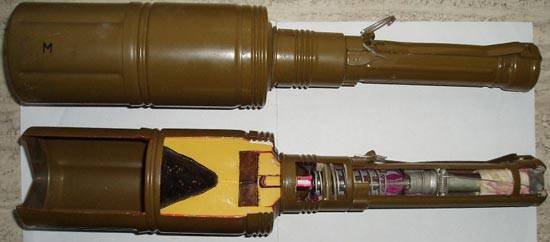 Training grenade RGC-3 and its cut
Training grenade RGC-3 and its cut
Compared with cumulative grenades, developed in wartime, RGC-3 design was more elaborate. To avoid accidents, antitank grenade has four protection. In preparing grenades for use, the handle was required to place the fuse, then fasten it to the body. After removal of checks with a ring occurred unlock the movable sleeve and strap. Inertial mechanism of the movable sleeve and a few beads were not allowed to work before the hammer mechanism, as a fighter will make the swing and throw a grenade to the target. After vigorous swing and throw the fuse compartment initiated hinged slats and the bottom of the handle cover.
After reset of the handle cover cloth ejected stabilizer. Reveal stabilizer oriented grenade warhead in the direction of flight and budge special spring bar, held in place by the balls and spring. Another was to fuse the hammer spring. In flight, it kept oscillating weight and drummer in the rearmost position. Tripping inertial impactor and undermine the cumulative charge could only occur on impact with the hard surface head portion grenades. While pomegranate has become safer, apply it only allowed out of hiding.
In the mid-50s for service to adopt a streamlined modification - GSC-3E and the GSC, the 3rd. ammunition design has not changed, improvement affected only the shaped charge and production technology. New grenade got a shaped charge with copper cladding cumulative funnel. Besides, changed the shape of the funnel. Thanks to completions armor grenades GSC-3E was 170 mm, and GSC-the 3rd - 220 gomogennoy booking.
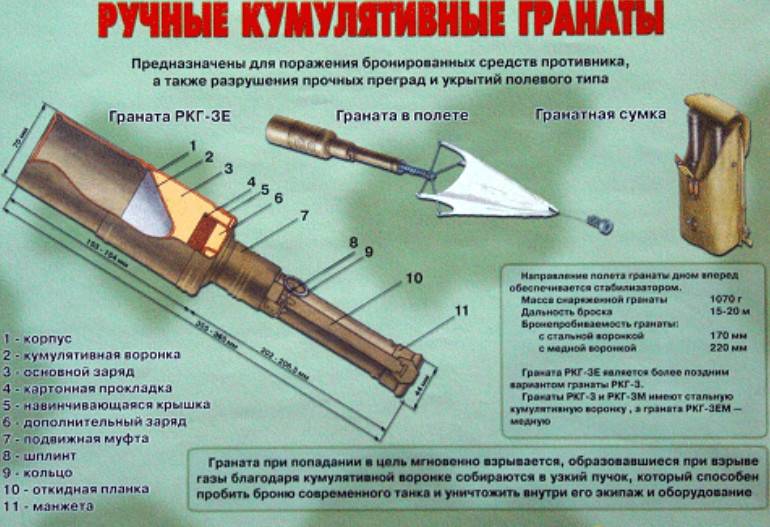
Anti-tank grenades RGC-3 family is a regular infantry weapons of the Soviet to adopting a disposable rocket-propelled grenade RPG-18 «Fly». Mobilization of stock in the warehouses of Defense of the Russian Federation, these grenades are still. In Soviet times, the RGC-3 is widely exported abroad and is actively used in regional wars. During the invasion of Iraq, US forces lost from the effects of these, it would seem, hopelessly obsolete ammunition several tanks and armored personnel carriers.
In the second half of the 50s in several design offices was carried creation rocket-propelled grenade. A new generation of anti-tank weapons were, least, twice the RPG-2 on the firing range and to ensure penetration of the frontal armor of all existing at the time of tanks, and also have a supply of armor-piercing, that allows you to fight with advanced armored vehicles. Besides, separately negotiate improved reliability and moisture resistance charge jet fuel.
AT 1957 year began testing RPG-4, created in GSKB-47. Actually RPG-4 are enlarged in size RPG-2. Unlike RPG-2 RPG-4 had increased charging barrel chamber and caliber 45 mm. With the simultaneous use of fuels based on nitroglycerin powder contributed to improve the initial speed and aiming a grenade firing range. On the breech for the purpose of dispersion of the jet appeared socket.
 RPG-4
RPG-4
Weight was grenade 4,7 kg, length -1200 mm. Blank range - 143 m. Sighting range - 300 m. Anti-tank grenade cumulative PG-2-caliber 83 mm and weight 1,9 kg, normal could punch 220 gomogennwyu bronyu. Stabilization grenades on the trajectory carried out a six-plate blades, which before the shot is in the folded state.
Antitank grenade launcher RPG-4 successfully passed field tests, and quite satisfied with characteristics of military. AT 1961 year pilot batch of grenades was released, intended for military trials. But, as is known, best the enemy of the good. Almost simultaneously with the RPG-4 was presented to the customer a better RPG-7, which later became the classic weapons and grenade launcher "of all time".
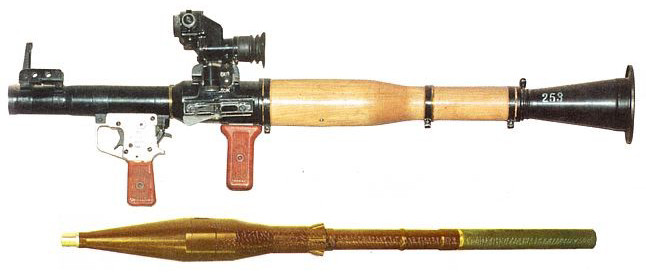 Rocket-propelled grenade and RPG-7 rocket-propelled grenade PG-7V
Rocket-propelled grenade and RPG-7 rocket-propelled grenade PG-7V
During the creation of the RPG-7 designers GSKB-47 took into account the experience of combat use of domestic and foreign anti-tank grenade launchers. The development was also attended by experts Kovrov Mechanical Plant and Tula TsKIB COO. Cumulative grenade and rocket engine developed under the leadership of VK. Firulina.
A unique feature of the antitank grenade PG-7V is the use of piezoelectric fuze. To stabilize the grenades used in flight four expandable blades. To improve the accuracy of shooting and error compensation in the manufacture of garnet due to the inclination of the stabilizer blades is transmitted to rotate at a speed of several tens of times per second. Nadkalibernaya 85mm antitank grenade PG-7 at a mass shooting 2,2 kg could break 260 mm armor.
The initial rate of grenades - about 120 m / s, at the end of the active portion increases until it 300 m / s. Due to the relatively high initial rate and the presence of the active portion of the jet engine operation, compared to PG-2, It managed to significantly increase the accuracy and firing range. When the blank range 330 m, Effective range — about 600 m.
 Anti-tank rocket-propelled grenade PG-7VM
Anti-tank rocket-propelled grenade PG-7VM
The basis of the design of RPG-7 successful technical solutions used RPG-2 with a starting device and reusable shot with nadkalibernoy warhead. In the middle of the RPG-7 has a special barrel Bolt, which allows for more efficient use of the energy of the propellant. To dissipate the jet is fired when the socket in the barrel breech.
Hand grenade launcher RPG-7, Besides mechanical sight, complete with an optical 2,7 fold sight PGO-7. The optical sight had range rangefinder grid and lateral correction, which increases the accuracy of fire and to effectively introduce amendments taking into account the range and speed of target movement. After adopting a new, more efficient cumulative grenades, on rocket launchers were mounted sights (PGO-7V, PGO-7V-2, PGO-7V-3 etc.) which takes into account the ballistics of various types of grenades. In addition to a full-time optical sight it is possible to install night sights. At the grenade with the suffix "H" has a mechanism, disables sight when fired, to prevent its exposure flash when fired.
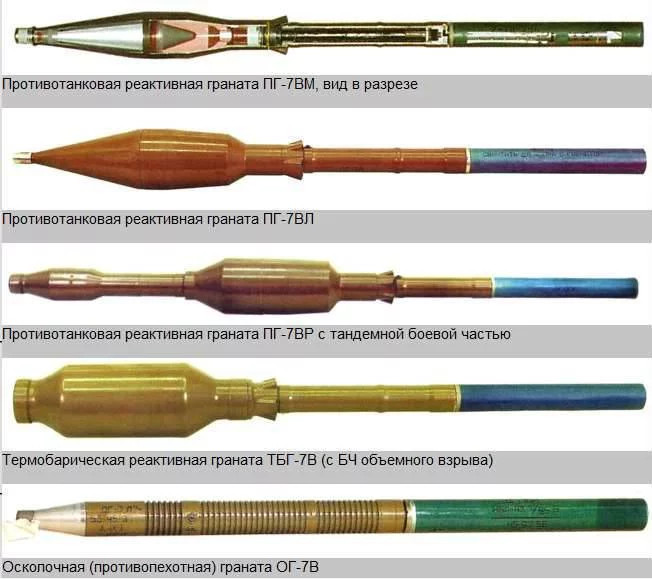
Depending on the modification and destination RPG 7-caliber ammunition have 40 -105 mm armor piercing to 700 mm for dynamic protection, and weight of 2 to 4,5 kg. In the 80-90 year "Basalt" specialists for the RPG-7 grenade shrapnel and thermobaric were created, that seriously increased the flexibility and combat effectiveness.
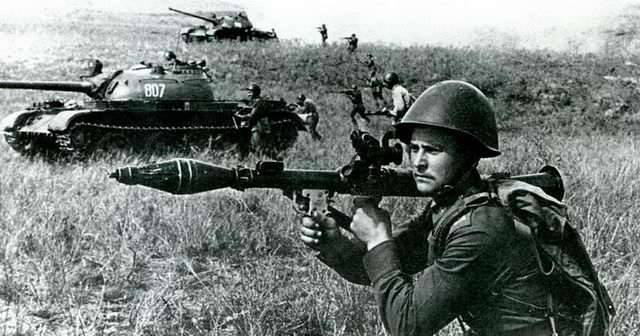
In the Land of the Soviet Army troops thrower had every motorized rifle compartment. RPG 7 for decades was the major type of antitank grenade launcher in the Soviet army. With a weight depending on the type of grenade 8,5-10,8 kg and length 950 mm grenade launcher could hit all the tanks potential enemy.
By order of the RPG-7D was created airborne troops, design that allows you to disassemble the barrel grenade launcher in preparation for landing. Grenade RPG-7, put into service in 1961 year, by creating shots for him increased efficiency is still able to fight with modern armored vehicles. By weight and size, and combat characteristics, the criterion of "cost-effectiveness", RPG-7 rocket-propelled grenades modern types still has no competitors.
RPG-7 was first used in combat in the mid-60s in Vietnam. Vietnamese guerrillas, who had already had the RPG-2 Soviet and Chinese production, quickly assessed the possibility of a new grenade launcher. With RPG-7 competed not only with the American armored vehicles, but also deliver effective strikes on the convoy and fortified positions. In the jungles of Southeast Asia revealed, antitank grenade launcher that can be effective against low-flying helicopters. Repeatedly there have been cases, when the pilots of US attack aircraft and fighter-bombers attack stopped or carried unsighted drop bombs, taking a shot from a grenade launcher for anti-aircraft missiles MANPADS. RPG 7 also performed well in the Arab-Israeli conflicts.
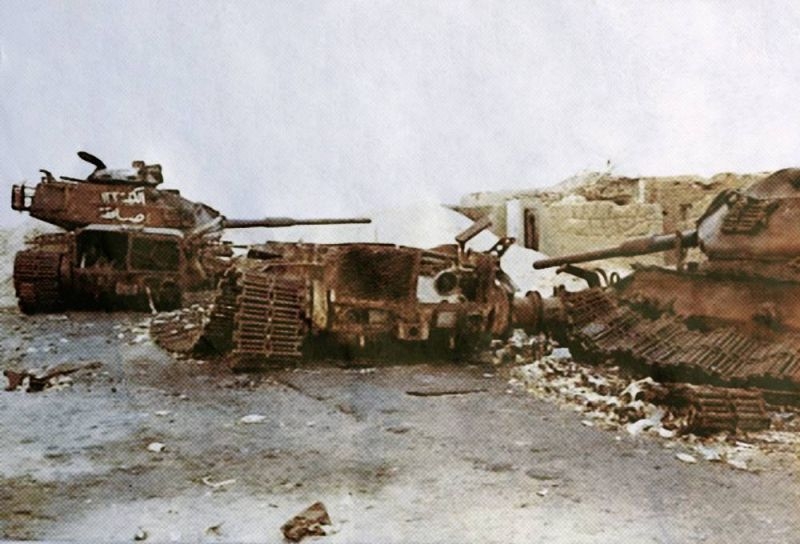 Israeli tanks destroyed
Israeli tanks destroyed
In the experience of the war, "Judgment Day" in the Syrian army was formed "anti-riot", soldiers who armed RPG-7 and portable ATRA. AT 1982 , the Syrian "anti-riot" has managed to strike the Israeli tankers significant losses during the fighting in Lebanon. When massive sighting firing rocket-propelled grenades are not always even helped "reactive armor» Blazer. An indirect recognition of the RPG-7 high fighting properties is the fact, that captured Soviet rocket launchers were in service in the IDF.
The RPG-7 is actively used in armed conflicts in the former Soviet Union, It is becoming a kind of "Kalashnikov" among grenade. It hits with grenades PG-7 connected by major losses of armored vehicles "coalition against terrorism" in Afghanistan and Iraq. While in the Russian Army, there are more modern anti-tank grenade launchers, RPG-7, the latest versions are the most widespread among the reusable grenade, the armament. It is one of the most common and effective sample light anti-tank weapons, RPG-7 used in the armies of more than 50 states. Given the number of copies of foreign produced RPG-7 is about 2 million. copies.
Simultaneously with the work on the creation of a light anti-tank grenade launcher, suitable to carry and use one shooter, It conducted the creation of machine-grenade, which is in range and accuracy of fire was eventually exceed LNG-82. Army Command was willing to significantly increase the effective range of fire antitank infantry units.
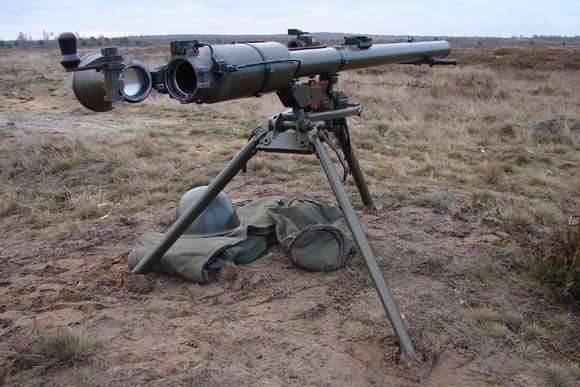 73-mm machine antitank grenade LNG-9
73-mm machine antitank grenade LNG-9
AT 1963 year has been adopted 73-mm machine antitank grenade LNG-9 "Spear". Same, as RPG-7, it was created in GSKB-47 (now the Federal State Unitary Enterprise "Basalt"). For firing a grenade launcher used by the active-reactive grenade PG-9, accelerates after engine operation to 700 m / s. Thanks to a sufficiently high airspeed, comparable with the rate of artillery shell, PG-9 compared to PG-7 had a much better accuracy rate and much longer range.
 Shells for SPG-9
Shells for SPG-9
The aft shot PG-9 is a jet engine, which started after the departure of the barrel grenade. The starting charge is composed of nitroglycerin powder sample in a fabric cap. Ignition starter charge by a special igniter with elektrozapalom. After the grenade left the barrel, shestipory disclosed stabilizer. In the tail of the PG-9 are tracers, with which you can watch on the flight path. Cumulative garnet depending on modification pierce 300-400 gomogennoy booking. How and PG-7, grenade PG-9 is equipped with a highly sensitive piezoelectric fuze.
Structurally, the SPG-9 — it is easy breech-loading recoilless gun, mounted on the tripod machine. When the length of the barrel 670 mm effective range of tanks is 700 m, which is more than twice as high as the RPG-7 range of conducting effective fire. rate up 6 rounds / min.
In the early 70's to the troops began to enter a modernized version of the SPG-9M. The composition of ammunition includes shots with increased armor penetration and increased to 900 meters blank range. By modernized heavy grenade launchers was adopted grenade OG-9. It has no jet engine, but only starting powder charge. Maximum OG-9 firing range — 4500 m. The new version of the grenade launcher equipped with iron sights PGOK-9, which consists of two separate sights: one for firing grenades cumulative direct fire, the second - for the use of fragmentation grenades.
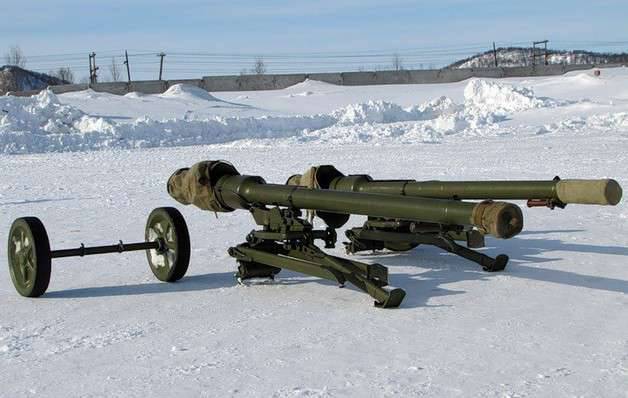
Mass grenade launcher is in the firing position 48 kg, length - 1055 mm. On the field of battle grenade launcher can be transported over short distances calculation of four. For transportation over long distances grenade disassembled into individual components. Especially for airborne troops created a modification to Wheel progress. Physical Specifications SPG-9 allow it to be mounted on a variety of vehicles and light armored vehicles. This quality was especially in demand in the Airborne and mobile reconnaissance and strike units. The regional wars grenade on mobile chassis, usually, We used not to fight with armored vehicles, and to engage manpower fragmentation grenades and destruction of lung shelters.
SPG-9, replacing the LNG-82, It is enough heavy weapons, I did not deserve such glory, some RPG-7. Nevertheless, the mounted grenade launchers are also widespread. In addition to the licensed production of Soviet grenade launcher SPG-9 and ammunition was carried out in a number of countries of the former Eastern Bloc. This weapon is well manifested itself in a variety of local wars. Relatively light weight and good accuracy enable efficient use of LNG-9 in street battles. Soviet heavy grenade launchers can be seen in the reports, shot in the South-East of Ukraine in Syria. Earlier this year, in the Russian media, that modernized SPG-9, equipped with the new night sights, used by Russian special forces as a weapon fire support.
AT 1970 year has been adopted quite unique rocket-propelled grenade RPG-16 "Strike", TKB created under the leadership of I.E. Rogozin. The uniqueness of a given sample, created specifically for Airborne, was that, that it was used Internal cylindrical 58,3 - kumulyatyvnaya mm grenade PG-16, and he could make out the grenade into two parts.
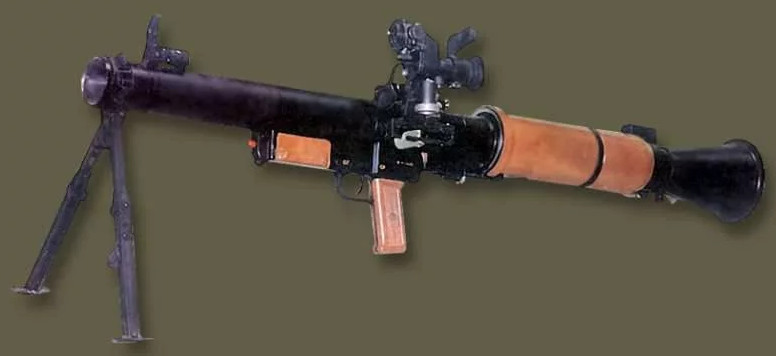 RPG-16
RPG-16
Due to their high primary and sustainer airspeed significantly increased blank range and precision. Circular error probable PG-16 at a distance 300 m was approximately 1,5 times less than, What the PG-7V. Range-blank was 520 m. Wherein, despite its relatively small size — 58,3-mm, grenade PG-16, through the use of more powerful explosive in combination with a copper cladding cumulative funnel and accurate selection of the focal length possessed armor penetration 300 mm.
In the same time, compared with RPG-7, specially designed landing grenade was larger and heavier. His weight was - 10,3 kg, and the length of the assembled - 1104 mm.
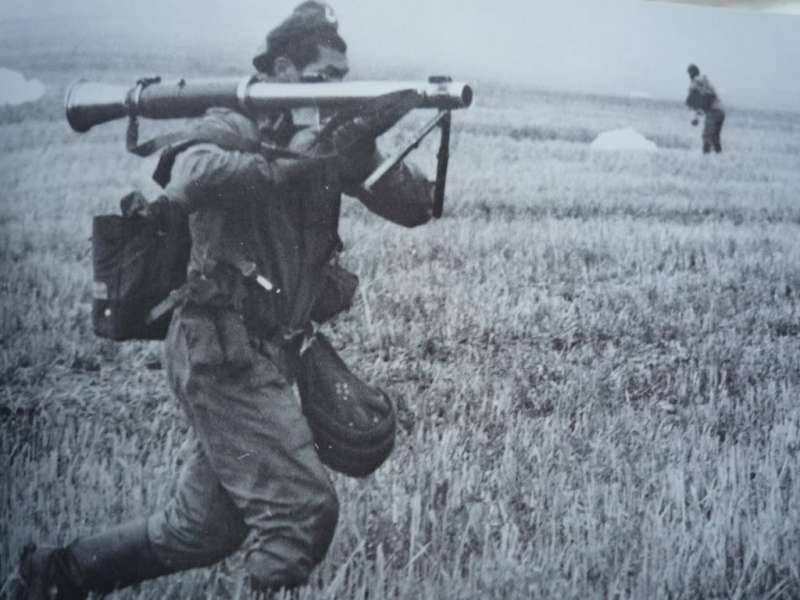 Desantnik with RPG-16
Desantnik with RPG-16
Surpassing the RPG-7 in range of effective fire nearly doubled, RPG-16 to a new generation of tanks with multilayer frontal armor fully satisfy the requirements. but, despite the high accuracy and a decent range of shooting, RPG-16 did not have upgrade potential. If the RPG-7, it was possible to increase the size of the cumulative grenades nadkalibernoy, in the case of PG-16 it was not possible.
In the end, after adopting the NATO "Abrams", "Challenger" and "Leopard-2" RPG-16 is rapidly outdated and desantura completely passed to the RPG-7D with the new high-power grenades. Information about using the RPG-16 was not found against armored vehicles, but landing caliber grenade launcher with the "loaded" barrel performed well in Afghanistan. Since the accuracy and firing range have been compared with the distance of the impact automatic gunfire, granatomotchiki, armed with RPG-16, effectively suppressed the rebels firing point. For this reason, even, despite the greater weight and dimensions, "Sniper grenade" were popular among the "limited contingent" of military. At present, the RPG-16 grenade launchers are on the bases of storage and line units of the Russian armed forces are not exploited.
To be continued…
Based on materials:
— http://weaponland.ru/load/granatomet_spg_82_sg_82/61-1-0-487
— http://russianguns.ru
— http://ryadovoy.ru/militarizm/antiarmored/grenade_RPG.htm







